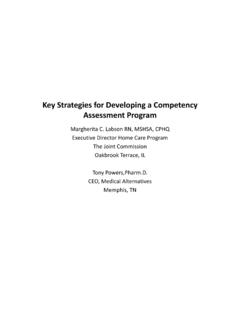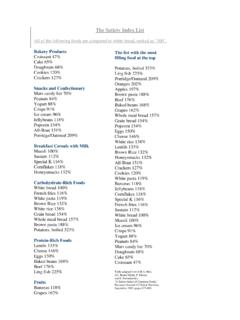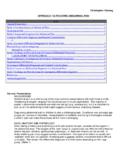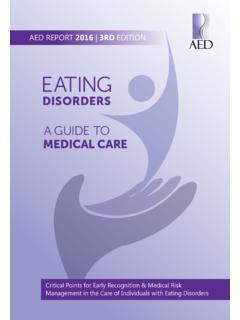Transcription of Inotropic Therapy: Key Considerations for Home Based Heart ...
1 Inotropic therapy : Key Considerations for Home Based Heart Failure PatientsFelicia Schaps, RN, CRNI , OCN, CNSC, CQA/Clinical Resource Nurse, HomeChoice Partners, Inc. A DaVita Company , Annandale, VATo p 4 Things to Know for CE1. Make sure your BADGE IS SCANNED each time you enter a session to record your attendance. 2. Carry your Evaluation Packet with you to EVERY Pharmacists, Pharmacy Technicians and Nurses need to track their hours on the Statement of Continuing Education Form as they go (the 2-page triplicate form, so press firmly!).4. FOR CE: At your last session, total the hours and sign both pages of your Statement of Continuing Education Form.
2 Keep the PINK copy for your records and place the YELLOW and WHITE copies in your CE Envelope. Make sure an Evaluation Form is in your CE Envelope for each session you attended (extra forms are available at the registration desk if you forgot to pick one up). Write your name and unique ID number (six digit number at the bottom of your name badge) in the designated area on the outside of the envelope, seal it, and place it in the drop box located near the registration Felicia Schaps declares no conflicts of interest or financial interest in any service or product mentioned in this program. Clinical trials and off-label/investigational uses may be discussed but in a fair and unbiased manner.
3 4/9/20123 ObjectivesAt the conclusion of this program the learner will be able to: Explain the purpose and action of Inotropic therapy and identify commonly used drugs Define patient selection criteria for home administration of Inotropic and ConfidentialObjectives Continued List the key clinical monitoring Considerations for the patient receiving Inotropic therapy Explain the primary goals of Inotropic therapy Describe reimbursement guidelines and Medicare coverage criteria for Inotropic therapyOverview Approximately 5 million people in the US suffer from congestive Heart failure Cardiac transplant is currently available to no more than 2.
4 500 people in the US a year CHF is a condition in which the Heart can no longer pump enough blood to meet the body s needs Decreased pumping causes fluid build up in major organs Pediatric failure is generally related to genetic defects and Duchenne Muscular DystrophyCongestive Heart FailureCauses Narrowing of blood vessels Cardiomyopathy Alcoholism and cocaine use Chemotherapy drugs End stage kidney disease High blood pressure Emphysema Hyper or hypothyroidismSymptoms Shortness of breath with activity Cough Swelling of feet and ankles Swelling of abdomen Weight gain Early satiety or indigestion Fatigue, weakness, faintness Difficulty sleepingSymptoms of CHFO ther Symptoms May Include Decreased alertness or concentration Decreased urine output Need to urinate at night Infants may sweat during feeding (or other activity)New Yo r k Heart Association (NYHA)Functional ClassificationsNYHA Functional Classification provides a simple way of classifying the extent of Heart ClassSymptomsINo symptoms and no limitation in ordinary physical activity, shortness of breath when walking, climbing stairs symptoms (mild shortness of breath and/or angina)
5 And slight limitation during ordinary limitation in activity due to symptoms, even during less-than-ordinary activity walking short distances. Comfortable only at restIVSevere limitations. Experiences symptoms even while at rest. Mostly bed bound Assessment Fluid in the lungs on auscultation Pitting edema of the legs Pelvic congestion Distended liver Distended jugular veins Irregular Heart rhythmJugular Venous DistentionDiagnostic Te s t sto confirm diagnosis Chest X ray ECG Echocardiogram Cardiac stress tests Heart catheterization Nuclear Heart scansInotrope Mechanism of Action Stimulates an injured or weakened Heart to pump harder to send blood through the body Increases cardiac output Decreases preload and afterloadMechanism of Action ContinuedIncreases force of contraction Increases ejection of blood Decreases
6 Wall tension Improves oxygenationRole of the Inotrope IV inotropes play a valuable role in improving the quality of life and functionality of end stage CHF patients who don t qualify for transplant or LVAD These patients will usually remain on service long termRole of the Inotrope Positive Inotropic therapy is administered to relieve symptoms due to poor perfusion and to preserve end organ function in patients with severe cardiac dysfunction or dilated cardiomyopathy It is of greatest value in patients with hypotension who have had no response to vasodilators and diureticsAgents Commonly Used in Alternate Site Milrinone Dobutamine DopamineContraindications Hypersensitivity to any component of the medication Patients with severe outflow obstruction, such as aortic stenosis or pulmonary stenosisSide Effects Chest pain Headache Hypertension Increased ventricular ectopy Nausea Palpitations Shortness of breath TachycardiaPatient Selection Criteria The Patient Should.
7 Be reliable, teachable and compliant Live within a reasonable distance from the office/nursing staff with a functional telephone Have a functional central line Have a significant other living with them who is also trained in all aspects of the therapyPatient Selection Criteria Have chronic intractable CHF Frequent hospitalization in spite of maximum oral medication therapy Be a New York Heart Association functional Class III or IV (may be awaiting transplant) On maximum doses of Digoxin, an ACE inhibitor, or a vasodilator, carvedilol, and a loop diureticPatient Selection Criteria Arrhythmias should be controlled prior to discharge Inotropic therapies may speed up the Heart rhythm and cause arrhythmias Many adult patients may have Automatic Implanted Cardioverter/Defibrillator (AICD)
8 Pediatrics patients will not usually have an AICDE quipment Required in the HomeIf not on Telehealth A reliable bathroom scale An automatic blood pressure cuff that also measures Heart rate A tape measure A thermometer Back up infusion pumpTelehealth in CHF Management Patients are monitored via electronic transmission of their medication intake, exercise, vital signs, weight etc. They can participate in video conferencing with nurses or physician specialists Widely used by the Veteran s Administration Study by Intel and Aetna presented at AHIP Institute showed evidence of reduced rehospitalization and health care costsNursing Assessment and InterventionsPatients should receive a full body assessment with every visit including.
9 Heart sounds Lung sounds Fluid retention (including neck veins) Record of weight and vital signs Record of intake and output Medication profile Changes in dietNursing Interventions Patient education is crucial Medication Side effects Monitoring of vital signs Nutrition Pre discharge interview with the patient is recommendedNursing Interventions Patient TeachingPatients will be instructed in the following topics: Measure daily weight, BP, HR and abdominal girth (if required) Self infusion of medication and maintenance of IV catheter Nutritional instruction including: Fluid and sodium restrictions How to understand nutrition labelingNursing InterventionTeachingregarding sodium is a MUCH bigger issue than just avoiding table InterventionsA two to three pound weight gain needs to be investigated!
10 Nursing Interventions Communication of your findings with the multidisciplinary team MD Pharmacy Nursing teamGoal is to Prevent Re hospitalization One of the most common factors that precipitates rehospitalization for Heart failure is non compliance by the patient to their medical regimen, or their sodium or fluid restrictions. Key is to educate the patient and monitor their status Vascular Access Device Centrally placed vascular access device (VAD) with the tip terminating in the superior vena cava PICC Port Hickman Groshong Note: Peripheral IV catheters are not appropriate for home use Administration Methods Infusion of Inotropic medications requires an ambulatory infusion device with alarmContinuous Infusion In the case of continuous infusion.











